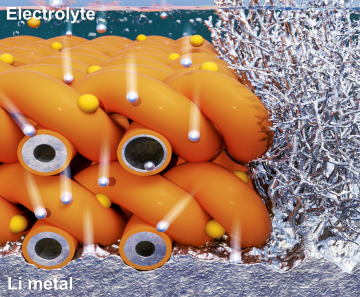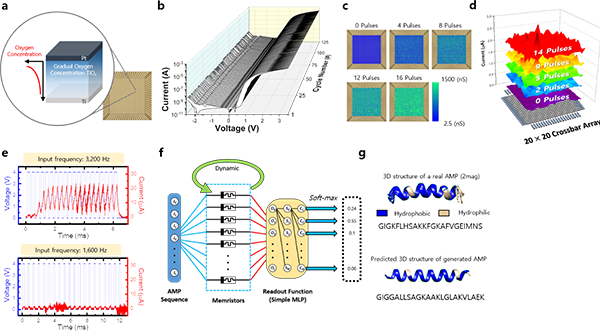KAIST
BREAKTHROUGHS
Research Webzine of the KAIST College of Engineering since 2014
Spring 2025 Vol. 24Highly reliable dynamic memristor for artificial neurons and neuromorphic computing
Highly reliable dynamic memristor for artificial neurons and neuromorphic computing
Professor Shinhyun Choi’s group has developed a dynamic memristor crossbar array with high reliability, enabling a memristor-based neuromorphic computing system for energy-efficient artificial intelligence.
Article | Fall 2022
A memristor is an emerging memory device that stores information using the electrical resistivity switching phenomenon. It is one of the most promising candidates for artificial intelligence (AI) hardware owing to its high scalability, good energy-efficiency, and analog properties, whereas the conventional complementary metal oxide semiconductor (CMOS)-based hardware is less satisfactory due to its high energy consumption. However, the application of existing memristor devices to a neuromorphic computing system has been limited due to the low reliability of these devices; for example, each memristor device in a chip shows different characteristics (device-to-device variations), while the operation of a single device also changes over time (cycle-to-cycle variation).
To address this issue, Prof. Shinhyun Choi’s group at the School of Electrical Engineering of the Korea Advanced Institute of Science and Technology (KAIST), has developed a new memristor with low cycle-to-cycle and device-to-device variations (1.39% and 3.87%, respectively). By using a TiOx layer with a gradual oxygen concentration, this new memristor possesses excellent dynamic resistive switching characteristics compared to previous memristors with large variations (> 30%) and a low yield. Using this newly developed memristor, Prof. Choi’s group has demonstrated an artificial neuron that shows high uniformity.
In addition, the group constructed a 20×20 memristor crossbar array that displayed behavior identical to that of a stand-alone device without any deterioration, which is necessary for a large-scale neuromorphic computing system. Furthermore, utilizing their memristor crossbar array, the group developed a novel neuro-memristive computing system that was capable of generating new protein sequences. Notably, this new system had fewer trainable parameters compared to the conventional long-short-term memory (LSTM) network, which is desired for a large-scale neuromorphic computing system.
The reliability of this newly developed memristor opens up the possibility of building novel electric hardware with large-scale integrated artificial neurons in the near future. It is expected that this highly reliable dynamic memristor can be utilized in various applications, such as artificial nerves for robotics, or in neuromorphic systems that utilize biologically plausible learning rules, and that it will enable the development of AI hardware with high levels of energy efficiency and yet small device sizes.
Most Popular

When and why do graph neural networks become powerful?
Read more
Smart Warnings: LLM-enabled personalized driver assistance
Read more
Extending the lifespan of next-generation lithium metal batteries with water
Read more
Professor Ki-Uk Kyung’s research team develops soft shape-morphing actuator capable of rapid 3D transformations
Read more
Oxynizer: Non-electric oxygen generator for developing countries
Read more
